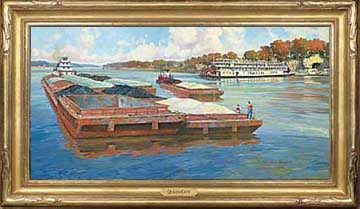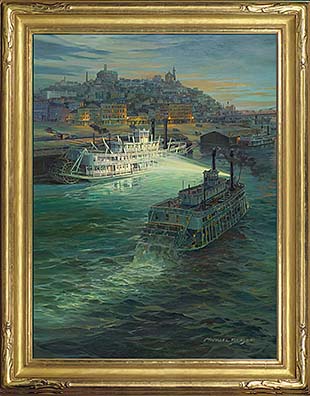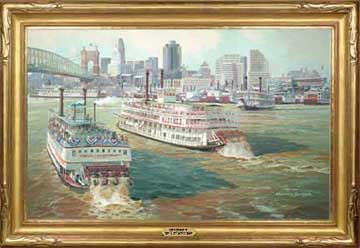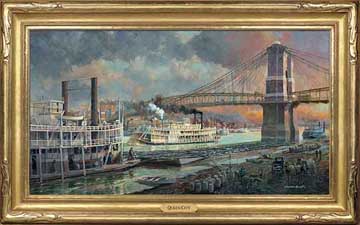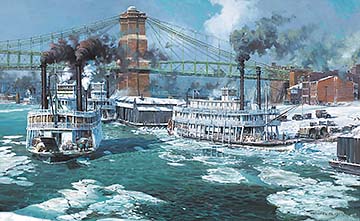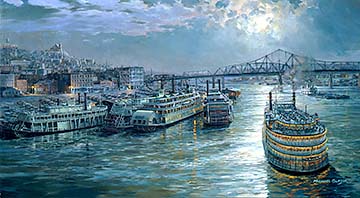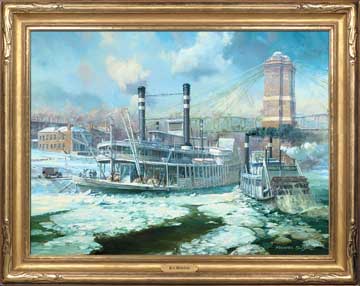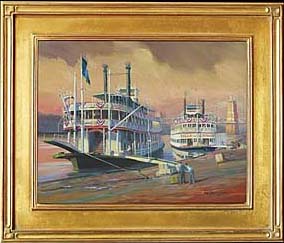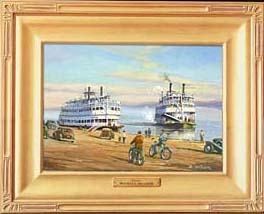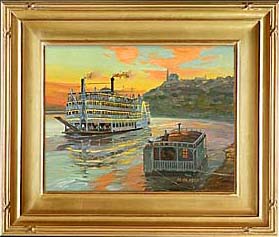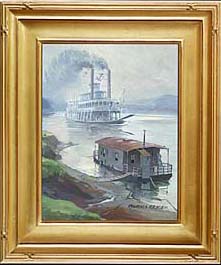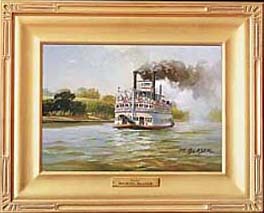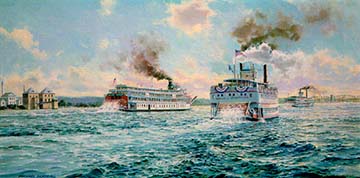
 |
 |
||||||||||

| Frame denotes print available as Giclee on canvas | Lawrenceburg, it was 1800 Yesterday |
|
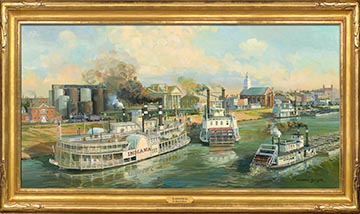 |




| Frame denotes print available as Giclee on canvas | Under The Bridge |
|
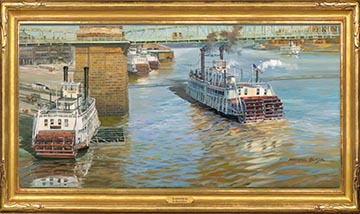 |


| Frame denotes print available as Giclee on canvas | Steamer Queen City Public Landing 1926 |
|
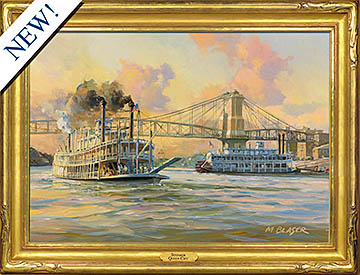 |




| Frame denotes print available as Giclee on canvas | Just before the Second World War The imposing towers of the Roebling Bridge have defined the Cincinnati skyline for over 150 years. Most of the waterfront buildings shown here have long since been buried beneath concrete. These ancient structures where the likes of Mark Twain, John James Audubon, and Stephen Foster once lived have been turned into the infield for the Cincinnati Reds. This scene is a formal portrait for the great steamer Gordon C. Greene. The Greene was for many years the pride of the Greene Line steamers of Cincinnati. The company gradually made the transition from carrying freight on the river to the overnight excursion business. Although Gordon C. Greene was a wonderful boat with a steel hull and up-to- date boilers, she lacked private bathing facilities in all the cabins. After the war, the Greene family brought the Delta Queen to the Ohio River and placed the Gordon C. Greene over on the Mississippi River. She was sold, meeting an unhappy fate when she eventually sank along the St. Louis waterfront in December of 1967. Flanking the Greene in this pre- war portrait are the wonderful Island Queen and, to the left, the sternwheel towboat, Julius Fleischmann. |
|
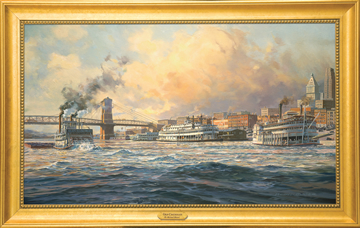 |
||
| Hand re-touched mounted (or stretched) giclée on canvas, framed as shown, sized 28 x 48 inches, plus frame with brass nameplate: $1,375 (plus shipping and crate). |
||
Hand retouched giclée on canvas with brass titleplate |


| Frame denotes print available as Giclee on canvas | The Kate Adams & J.T. Hattfield meet on the Ohio River The Steamer KATE ADAMS was affection- |
|
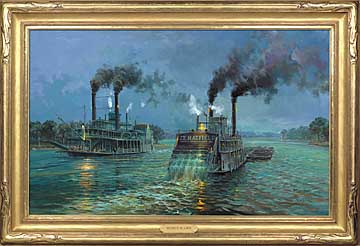 |
||
The hand re-touched, framed giclée mounted or |
||
An unframed hand re-touched giclée with brass Paper print, sized 18 x 32 inches: $175, plus $20 shipping |
||


| Frame denotes print available as Giclee on canvas | The Arrival of the Steamer Delta Queen to join the Greene Line fleet March 1948 Most fans and former passengers of the Steamer DELTA QUEEN are aware that the grand old lady was towed over the open ocean from San Francisco thru the Panama Canal, up the Mississippi to Cincinnati. She was restored at Dravo Marine near Pittsburgh and then steamed down to Cincinnati to join the Greene Line in the spring of 1948. |
|
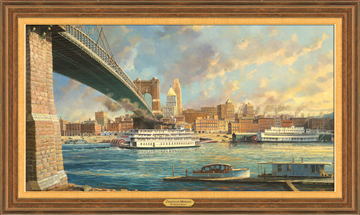 |
||
Hand retouched giclée on mounted or stretched |
||
Unframed rolled hand retouched giclée on canvas with Print on Paper 16 X 30 inches including shipping |


| Frame denotes print available as Giclee on canvas | Here is the magic of a moonlit night on the Ohio River. Cincinnati people have always had a special relationship to the river. From the famous Greene Line home port with the steamers GORDON C. GREENE and DELTA QUEEN, to a hundred others lost to the history books. A special boat stands out to those who could not afford an overnight adventure on the river. She was the ISLAND QUEEN. Mostly, she plied the riverfront from the Public Landing upstream to the famous Coney Island Amusement Park. The Moonlight Gardens was a huge open dance area where adults could romance the night away, while the kids rode the roller coaster and other family rides. Then, at the appointed hour, the steamer would blow her whistle, and crowds would board for the return trip to the Public Landing. The boat featured a massive dance floor and live band music for the return trip. ISLAND QUEEN often wintered in New Orleans as a harbor-cruise boat. While on a charter to Pittsburgh in 1947, she caught fire and burned. To many native Cincinnati residents, it was like losing a member of the family. |
|
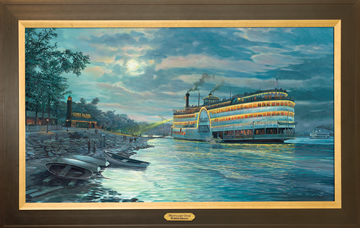 |
||
Hand re-touched giclée on mounted or stretched canvas, |
||
Unframed hand retouched giclée on canvas rolled |






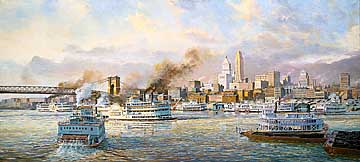 |
The first in a series of four reproductions on the dramatic and great waterfront heritage of Cincinnati. The Island Queen, affectionally known as “Big Liz” was still transporting her passengers daily to Coney Island in 1935.
Edition Size: 950 |


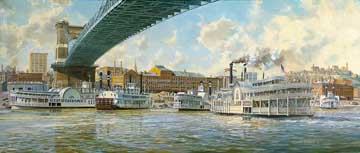 |
The history of the great packet fleet along the Ohio River is legend. The original Island Queen built in Cincinnati in 1896 is shown at the right. On November 4, 1922, she along with the steamers Morning Star, Chris Greene and Tacoma were destroyed in a fire at the Public Landing.
Edition Run: 950 |


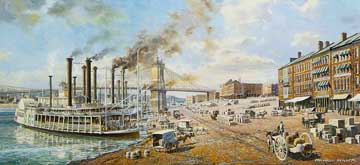 |
In 1875 the cotton business on the lower Mississippi was reaching its zenith. Much of this trade was controlled by vessels owned or constructed in the Cincinnati such as the Thompson Dean. She was built in Cincinnati in 1872.
Edition Run: 950 |


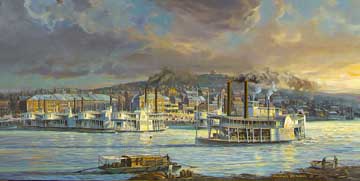 |
The sun rises slowly over the bustling Ohio River metropolis. The sidewheeler Cincinnatus steams towards the Public Landing past the facade of Casilly's Row and Mt. Adams.
Edition Run: 950
|






| Frame denotes print available as Giclee on canvas | The last days of navigation on the Ohio River in December of 1917 The Ohio River is typically navigable, year-round. If a freeze occurs, today’s steel-hulled towboats can usually make their way through the ice without difficulty. The winter of December 1917 and January “The CITY OF LOUISVILLE” was as fabled on the Ohio as the ROB’T. E. LEE was on the Mississippi. Her great size and power called for the supreme pilots of her day. As Capt. Ed Maurer once said “When you had her hard down rattling around Sugar Creek Bend, she was a whole lot of lumber. She left Louisville on May 16th |
|
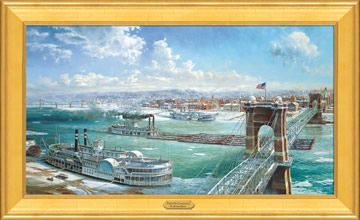 |
||
The hand re-touched giclée on mounted (or stretched) canvas is |
||
Unframed hand re-touched canvas: $875 |






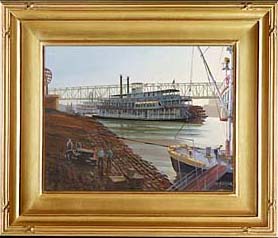 |
Steamer Natchez Dawn breaks over the Cincinnati Public Landing as the steamer Natchez arrives for the start of Tall Stacks 2006. Making her first appearance at Tall Stacks, the Natchez was the "belle of the ball". Designed by Alan L. Bates, Louisville, Ky. the contours of the Natchez can only be described as "perfection on the water". She is one of the remaining six working steamboats on the Inland Rivers. Edition size - 150 Artist Hand Retouched Giclee On Canvas Image Size 11" x 14" Retail Price - $175.00 |










Copyright 2013 – Michael Blaser
Reproduction in part or whole without written permission is prohibited
Site Maintained By: Beyond Cyber Concepts
